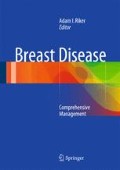Abstract
Recently, patient navigation has received a great deal of attention. The scope and importance of patient navigation, especially in a multidisciplinary breast cancer program, will be addressed. In discussing patient/nurse navigation, there are several different models of navigation identified, each having individual strengths and weaknesses. A breast cancer patient navigator fulfills a critical role for many patients who are just learning that they have been diagnosed with breast cancer.
Access this chapter
Tax calculation will be finalised at checkout
Purchases are for personal use only
References
Freeman HP. A model patient navigator program. Oncol Issues. 2004;19(5):44–6.
Patient navigation concept. http://crchd.cancer.gov/pnp/concept.html.
Freeman HP, Muth BJ, Kerner JF. Expanding access to cancer screening and clinical follow-up among the medically underserved. Cancer Pract. 1995;3(1):19–30.
Newman-Horm PA, C-Change. Cancer patient navigation: published information. Washington DC: C-Change; 2005.
Cancer Care Nova Scotia. Cancer patient navigation evaluation: final report. Halifax: Cancer Care Nova Scotia; 2004.
Fowler T, Steakley C, Garcia AR, Kwok J, Bennett LM. Reducing disparities in the burden of cancer: the role of patient navigators (serial online). PLoS Med. 2006;3:e193.
Wells KJ, Battaglia TA, Dudley DJ, Garcia R, Greene A, Calhoun E, et al. Patient navigation: state of the art or is it science. Cancer. 2008;13(8):1999–2010.
Gentry S. Navigation principles across the continuum. J Oncol Navig Surviv. 2012;3:30–4.
Patient Navigation in Cancer Care Web site. What is patient navigation? http://www.patientnavigation.com. Accessed 26 Dec 2012.
NCI. providing information and education, and providing links to resources. 2005. http://www.cancer.gov/cancertopics/cancerlibrary/othersites#top.
Battaglia TA, Roloff K, Posner MA, Freund KM. Improving follow-up to abnormal breast cancer screening in an urban population: a patient navigation intervention. Cancer. 2007;109(2 suppl):359–67.
BC Cancer Agency. Patient navigation in cancer care: summary report. 2005. http://www.bccancer.bc.ca/WebSummaryNavigation.pdf.
Dohan D, Schrag D. Using navigators to improve care of underserved patients: current practices and approaches. Cancer. 2005;104(4):848–55.
Ferrante JM, Chen PH, Kim S. The effect of patient navigation on time to diagnosis, anxiety, and satisfaction in urban minority women with abnormal mammograms: a randomized controlled trial. J Urban Health. 2007;85:114–24.
Fowler T, Steakley C, Garcia AR, Kwok J, Bennett LM. Reducing disparities in the burden of cancer: the role of patient navigators. PLoS Med. 2006;3:974–6.
Freund KM, Battaglia TA, Calhoun E, Dudley DJ, Fiscella K, Paskett E, et al. National Cancer Institute Patient Navigation Research Program: methods, protocol, and measures. Cancer. 2008;113:3391–9.
Pedersen A, Hack T. Pilots of oncology health care: a concept analysis of the patient navigator role. Oncol Nurs Forum. 2010;37(1):55–60.
Role of the navigator. www.AONNonline.org.
Shockney LD. Becoming a breast cancer nurse navigator. Sudbury, MA: Jones and Bartlett; 2011.
McDonald C. A first-hand look at the role of the breast cancer nurse navigator. Care Manag. 2011/2012;17(6):11–4.
Brown GB, Cantril C, McMullen L, Barkley D, Dietz M, Miller Murphy C, et al. Oncology nurse navigator role delineation study: an oncology nursing society report. Clin J Oncol Nurs. 2010;16:581–5.
Korber SF, Padula C, Gray J, Powell M. A breast navigator program: barriers, enhancers, and nursing interventions. Oncol Nurs Forum. 2011;38:44–50.
Case MA. Oncology nurse navigator: ensuring safe passage. Clin J Oncol Nurs. 2011;15(1):33–40.
Stephens PA, Osowski M, Fidale MS, Spagnoli C. Identifying the educational needs and concerns of the newly diagnosed breast cancer patient after surgery. Clin J Oncol Nurs. 2008;12(2):253–8.
Merriam-Webster. www.merriam-webster.com/dictionary/ripple%20effect. Accessed 26 Dec 2012.
McDonald J, Abella P. The impact of nurse navigation on the patient experience. J Oncol Navig Surviv. 2012;3(5):10–4.
Gertels M, Edgman-Levitah S, Daley J, et al., editors. Through the patient’s eyes, understanding and promoting patient-centered care. San Francisco: Jossey-Bass; 1993.
Institute of Medicine, Committee on Quality of Health Care in America. Crossing the quality chasm: a new health system for the 21st century. Washington DC: National Academies Press; 2001.
Author information
Authors and Affiliations
Corresponding author
Editor information
Editors and Affiliations
Rights and permissions
Copyright information
© 2015 Springer Science+Business Media New York
About this chapter
Cite this chapter
Stephens, P.A. (2015). The Multidisciplinary Breast Cancer Program: Patient Navigation. In: Riker, A. (eds) Breast Disease. Springer, New York, NY. https://doi.org/10.1007/978-1-4939-1145-5_32
Download citation
DOI: https://doi.org/10.1007/978-1-4939-1145-5_32
Published:
Publisher Name: Springer, New York, NY
Print ISBN: 978-1-4939-1144-8
Online ISBN: 978-1-4939-1145-5
eBook Packages: MedicineMedicine (R0)

